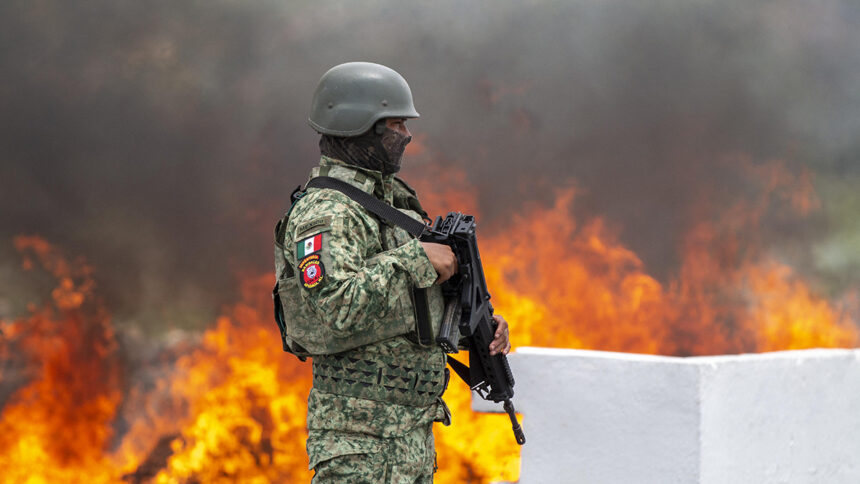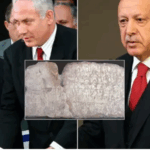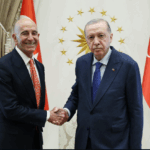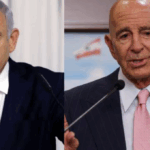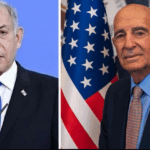Mexico’s Long War: Drugs, Crime, and the Cartels
Introduction
Mexican authorities have been waging a deadly battle against drug cartels for nearly two decades, but with limited success. Thousands of Mexicans—including politicians, students, and journalists—die in the conflict every year. The country has seen more than 431,000 homicides since 2006, when the government declared war on the cartels.
The United States has partnered closely with its southern neighbor in this fight, providing Mexico with billions of dollars to modernize its security forces, reform its judicial system, and fund development projects aimed at curbing irregular migration. Washington has also sought to stem the flow of illegal drugs into the United States by bolstering security and monitoring operations along its border with Mexico. Under U.S. President Joe Biden, the two countries adopted a new framework to address insecurity in Mexico and the U.S. opioid crisis, though bilateral relations have become strained amid concerns over Mexican President Andrés Manuel López Obrador’s alleged financial ties to cartels.
What drugs do the cartels traffic?
Mexican drug trafficking organizations (DTOs)—sometimes referred to as transnational criminal organizations—dominate the import and distribution of cocaine, fentanyl, heroin, marijuana, and methamphetamine in the United States. Mexican suppliers are responsible for most heroin and methamphetamine production, while cocaine is largely produced in Colombia and then transported to the United States by Mexican criminal organizations. Mexico, along with China, is also a leading source of fentanyl, a synthetic opioid up to fifty times more potent than heroin and easier to produce.
At the same time, the cartels smuggle vast quantities of marijuana into the United States, even though some U.S. jurisdictions have legalized it. Conversely, California’s booming cannabis industry has prompted traffickers to smuggle U.S.-grown marijuana across the border to Mexico, where lawmakers have yet to fully legalize the drug.
Which are the largest cartels?
Mexico’s drug cartels are in a constant state of flux. Over the decades, they have grown, splintered, forged new alliances, and battled one another for territory. The two cartels that pose the most significant drug trafficking threats [PDF] to the United States, according to the U.S. Drug Enforcement Administration (DEA), are:
Sinaloa Cartel. Formerly led by Joaquín “El Chapo” Guzmán, Sinaloa is one of Mexico’s oldest and most powerful drug trafficking groups with considerable influence in the Mexican government and public institutions. In addition to fentanyl trafficking, the group engages in extortion, migrant smuggling, oil and mineral theft, prostitution, and the weapons trade. With strongholds in nearly half of Mexico’s states—particularly those along the Pacific coast in the northwest and near the country’s southern and northern borders—and operations in at least forty-seven countries, it has a larger international footprint than any of its Mexican rivals.
In 2017, Mexican authorities extradited Guzmán to the United States, where he is serving a life sentence for multiple drug-related charges. U.S. President Joe Biden has sanctioned more than a dozen members of Sinaloa and several associated Mexico-based companies.
More on:
Jalisco New Generation Cartel (CJNG). Jalisco splintered from Sinaloa in 2010 and is among Mexico’s fastest-growing cartels, with operations in some two-thirds of the country. It is also present in more than three dozen countries and all fifty U.S. states. Like Sinaloa, the CJNG is one of the largest producers and traffickers of fentanyl to the United States, in addition to cocaine, methamphetamine, and several other drugs. It is also involved in fuel theft, extortion, and migrant smuggling. The group’s success is linked to its control over several Mexican ports, granting it greater access to the global drug supply chain.
Other major cartels include:
Beltrán-Leyva Organization (BLO). The group formed when the Beltrán-Leyva brothers split from Sinaloa in 2008. Since then, all four brothers have been arrested or killed, but their loyalists continue to operate throughout Mexico. The organization’s splinter groups have become more autonomous and powerful, maintaining ties to Jalisco, Juárez, and Los Zetas.
Los Zetas. Originally a paramilitary enforcement arm for the Gulf Cartel, Los Zetas was singled out by the DEA in 2007 as the country’s most “technologically advanced, sophisticated, and violent” group of its kind. It splintered from the Gulf Cartel in 2010 and held sway over swaths of central, eastern, and southern Mexico. However, it has lost power in recent years and fractured into rival wings.
Guerreros Unidos (GU). Based in southwestern Mexico, Guerreros Unidos (United Warriors) broke away from the BLO in 2009 and became involved in the heroin trade. The group is known to have a partnership with the CJNG, using the same transportation networks to move drug shipments to and from the United States.
Gulf Cartel. Its base of power is in the northeastern state of Tamaulipas, where it is thought to be working with CJNG members, though it also reportedly has operations in several other states on the Gulf coast. In the past decade, the group has splintered into various factions, diluting its strength as it battles for territory with Los Zetas. In 2021, three warring Gulf factions announced they had reached a truce, insisting that they wanted to maintain peace in Tamaulipas.
Juárez Cartel. A long-standing rival of Sinaloa, Juárez has its stronghold in the north-central state of Chihuahua, across the border from New Mexico and Texas. The group has lost considerable power since 2014, when Mexican authorities arrested its leader Vicente Carrillo Fuentes. In recent years, it has splintered into several factions.
La Familia Michoacána (LFM). Formed in the 1980s, LFM has its base in western Mexico’s Michoacán state. In 2009, U.S. President Barack Obama designated the group’s members as “significant foreign narcotics traffickers” and imposed financial sanctions on it under the Foreign Narcotics Kingpin Designation Act. While the group has weakened and fragmented in recent years, some experts say it has revived.
Los Rojos. Another splinter group of the BLO, Los Rojos operates primarily in central and southwestern Mexico and relies largely on kidnapping and extortion, as well as trafficking of drugs such as cocaine and heroin. Although several of its leaders were arrested between 2019 and 2020, the group remains active, and along with Guerreros Unidos, has been linked to the 2014 disappearance and murder of forty-three students from a university in Guerrero state.
What led to the cartels’ growth?
Experts point to both domestic and international forces. The cartels use a portion of their vast profits to pay off judges, police, and politicians, while serving as one of the country’s top employers. They also coerce officials into cooperating; assassinations of journalists and public servants are relatively common. The 2024 election was the most violent in six years, with more than thirty candidates killed.
The cartels flourished during the seven decades that Mexico was ruled by a single party, the Institutional Revolutionary Party (PRI). Within this centralized political structure, drug trafficking groups cultivated a wide network of corrupt officials through which they were able to gain distribution rights, market access, and protection.
The PRI’s unbroken reign finally ended in 2000 with the election of President Vicente Fox of the conservative National Action Party (PAN). With new politicians in power, cartels ramped up violence against the government in an effort to reestablish their hold [PDF] on the state.
At the international level, Mexican cartels began to take on a much larger role in the late 1980s, after U.S. government agencies broke up Caribbean networks used by Colombian cartels to smuggle cocaine. Mexican gangs eventually shifted from being couriers for Colombian criminal organizations, including the infamous Cali and Medellín cartels, to being wholesalers. By 2007, Mexican cartels controlled an estimated 90 percent [PDF] of the cocaine entering the United States.
The U.S. government, despite spending more than $1 trillion on its “war on drugs” since the 1970s, has made little progress in reducing demand. In 2017, Americans spent $153 billion [PDF] on illegal drugs, including cocaine, heroin, marijuana, and methamphetamine. The growing use of synthetic opioids, including fentanyl, has contributed to a public health crisis.
How are drugs smuggled into the United States?
Most of the illicit drugs entering the United States that are seized by authorities are discovered at official ports of entry, of which there are more than three hundred.
Traffickers employ various tactics to evade detection by U.S. authorities at the border. These include hiding or disguising drugs in vehicles or maritime vessels, smuggling them into the United States through underground tunnels, and flying them over border barriers using drones or other aircraft. After Mexican traffickers smuggle wholesale shipments of drugs into the United States, local groups and street gangs manage retail-level distribution in cities throughout the country.
What measures has Mexico taken to stem the drug trade?
Recent Mexican administrations have responded to cartels primarily by deploying security forces, often spurring more violence:
Felipe Calderón (2006–2012). President Calderón declared war on the cartels shortly after taking office. Over the course of his six-year term, he deployed tens of thousands of military personnel to supplement and, in many cases, replace local police forces he viewed as corrupt. With U.S. assistance, the Mexican military captured or killed twenty-five of the top thirty-seven drug kingpins in Mexico. The militarized crackdown was a centerpiece of Calderón’s tenure.
However, some critics say Calderón’s decapitation strategy created dozens of smaller, more violent drug gangs. Many also argue that Mexico’s military was ill-prepared to perform police functions. The government registered more than 120,000 homicides [PDF] over the course of Calderón’s term, nearly twice as many as during his predecessor’s time in office. (Estimates from a 2018 report reveal that between one-third and one-half of the homicides in Mexico are linked to cartels.)
Enrique Peña Nieto (2012–2018). Calderón’s successor said he would focus more on reducing violence against civilians and businesses than on removing the leaders of cartels. Still, President Peña Nieto relied heavily [PDF] on the military, in combination with the federal police, to battle the cartels. He also created a new national police force, or gendarmerie, of several thousand officers.
Homicides declined in the first few years of Peña Nieto’s presidency. But 2015 saw an uptick, and by the end of his term, the number of homicides had risen to the highest level in modern Mexican history. Experts attribute this to the continued fallout from the kingpin strategy, territorial feuds, and cartel fragmentation.
Andrés Manuel López Obrador (2018–present). Shortly after taking office, President López Obrador, also known as AMLO, announced that his government would move away from militarized attempts to apprehend cartel leaders and instead focus on improving regional security cooperation and reducing homicide rates. His “hugs not bullets” approach seeks to address the socioeconomic drivers of organized crime by creating job opportunities. Since 2018, his administration has launched an anticorruption drive and disrupted cartel finances; it has also proposed decriminalizing all illegal drugs and offering amnesty to low-level cartel members.
Though AMLO framed his strategy as a novel approach, some experts say his actions—including deploying a new military-led national guard to boost security—echo his predecessors’ tactics and are unsuccessful. AMLO also faced scrutiny over his alleged financial ties to cartels, and relations with U.S. policymakers have become increasingly tense. Meanwhile, the homicide rate continues to hover around record levels.
What has been the toll on human rights?
Civil liberties groups, journalists, and foreign officials have criticized the Mexican government’s war with the cartels for years, accusing the military, police, and cartels of widespread human rights violations, including torture, extrajudicial killings, and forced disappearances. As of 2022, nearly ninety thousand people have disappeared since 2006, primarily at the hands of criminal organizations such as the cartels, though government forces also play a role. (Experts say the real figure could be higher.) Local search efforts to find the missing and prosecute those responsible have often been stymied by cartel-related violence, government incompetence and corruption, and other factors.
One prominent example of this was the 2014 abduction and presumed murder of forty-three students in Guerrero state, which prompted mass demonstrations over officials’ perceived incompetence and complicity. Later investigations purportedly found evidence that the police, military, and judicial authorities conspired with the cartels to carry out and cover up the crime.
In recent years, vigilante groups [PDF] known as autodefensas have sought to fill in where security forces have failed to protect communities from criminal groups. They have become a formidable force against the cartels in states including Guerrero and Michoacán. However, some vigilantes have committed rights abuses, including the recruitment of child fighters; allegedly maintained ties to cartels in exchange for weapons and protection; and even turned to organized crime themselves.
What assistance has the U.S. government provided?
The United States has cooperated with Mexico on security and counternarcotics to varying degrees over the past several decades. Under Presidents George W. Bush and Calderón, bilateral efforts centered on the Mérida Initiative; since the two leaders launched the partnership [PDF] in 2007, the United States has appropriated more than $3.5 billion for it. This assistance has gone toward purchases of military aircraft, surveillance software, and other equipment.
The initial phase of the initiative, which ended in 2010, evolved to reflect the priorities of national leaders. The Bush administration focused heavily on providing Mexico with security-related assistance, including counternarcotics and counterterrorism support. President Barack Obama widened the scope of aid to target fundamental reforms to Mexico’s justice system and to develop crime-prevention programs at the community level, among other efforts, in what became known as “Mérida 2.0” [PDF].
President Donald Trump shifted U.S. priorities for Mérida to issues including border security and combating drug production and money laundering. In a highly controversial move in February 2019, Trump declared a national emergency at the U.S.-Mexico border and ordered the deployment of thousands of active-duty military troops there, citing an influx of illicit drugs, criminals, and undocumented immigrants. Mexico later deployed twenty-five thousand National Guard members to secure its borders, which some experts say increased violence and diminished the country’s cartel-fighting capacity.

The U.S.-Mexico relationship took a major hit in October 2020, when U.S. authorities arrested General Salvador Cienfuegos Zepeda, a former Mexican defense minister, in Los Angeles for drug trafficking and money laundering. Though the United States later dropped the charges and allowed Cienfuegos to return to Mexico, the Mexican government responded by restricting U.S. law enforcement agents’ power to operate in the country.
President Biden inherited a tense security relationship with Mexico, with bilateral cooperation focused mostly on migration, the COVID-19 pandemic, and trade. Presidents Biden and López Obrador initially announced the creation of a new framework to address both insecurity in Mexico and the opioid crisis in the United States, but in 2022, AMLO disbanded a DEA-trained anti-narcotics force that had worked closely with U.S. law enforcement for decades. Despite some progress on implementing the framework, including an increase in arrests for arms and drug traffickers, bilateral relations have become increasingly strained by perceptions among some in Washington that AMLO has not done enough to tackle the problem.
Advisors for Mexican President-Elect Claudia Sheinbaum, who will take office in October, said she will aim to reduce the homicide rate by increasing the number of federal investigators, expanding the National Guard, and combating impunity via judicial reforms.
by Claire Klobucista and Mariel Ferragamo
Source: Council on Foreign Relations (CFR)

